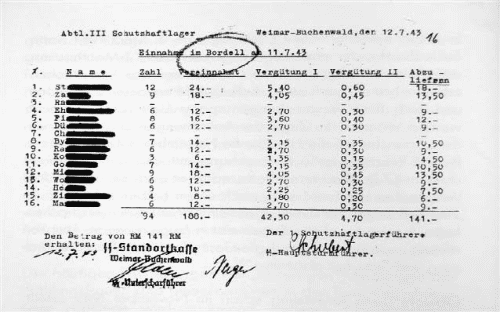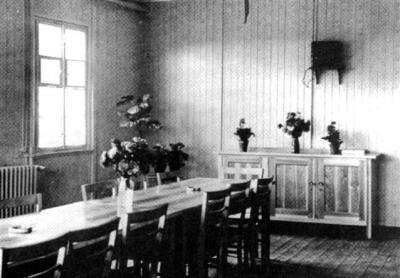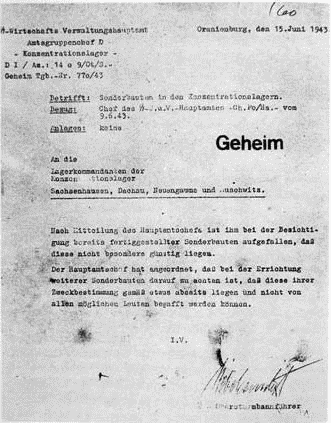Forced Prostitution in State Brothels built by the National Socialists
A Review
Christa Paul, Zwangsprostitution, Edition Hentrich, Berlin, 1994, 240 S., €39.80

Ill. 1: “The German Labor Front, June 1942, Confidential. Re.: Setting up brothels for foreign workers”.

Ill. 2: Balance sheet of the brothel in Buchenwald concentration camp, July 12, 1943.
Imagine for a minute that the economy of your country was booming so well that your government imported a few million young European men to work in the fields and factories and then, a major war broke out and you and your countrymen were sent off to fight that war and you had to leave your wife or girlfriend at home alone…
Well, not quite alone as there are still a few million good looking healthy young Italians, Frenchmen, Dutchmen, Poles etc. living up the road, only too willing to take your place. It was exactly this scenario that millions of young German men faced after being sent off to fight in WWII.
The German government knew only too well how their men felt about leaving their women, so they decided to offer young ladies-of-the-night the choice between just sitting around in a labor camp or concentration camp doing nothing (because prostitution had been outlawed by the National Socialists), or carrying on with the profession these ladies had chosen to follow before war broke out, i.e., work in a brothel.

Ill. 3: Waiting room of the Buchenwald camp brothel.
The German Ministry for Labor and “Good Ideas” set up brothels for the foreign Laborers in the labor camps and in most concentration camps in order to keep the inmates occupied, satisfied, and away from German women.
Yes I know, the book is called “Zwangsprostitution” meaning forced prostitution, but the truth is that the title of the book is just as deceptive as the term “Zwangsarbeiter” (=Forced Laborer), because most of these people were paid for their work and even got vacations and social benefits. If the Nazis had decided to force these women to prostitute themselves, they had the power to do it without the women being paid.

Ill. 4: Letter of SS Main Office of June 15, 1943, to Sachsenhausen, Dachau, Neuengamme, and Auschwitz camps, ordering that future brothels have to be built at discrete places where inmates cannot gape at what is going on in them.
The scan in illustration 2 shows the turnover for the Concentration Camp Brothel of Buchenwald on the 11.07.1943. This scan, however, tells us more than just the income for the Buchenwald brothel on that one day. It also tells us that on that one day in 1943, sixteen women catered for ninety-four (94) customers and that (Reichsmarks) RM 188.– exchanged hands.
For a prisoner to visit a camp brothel he had to apply, and the application form looked like the one in illustration 5.

Ill. 5: Application form for prisoners in the Mauthausen concentration camp to spend time at the camp brothel.
The laws in the camps, however, forbade prisoners from keeping sums of money with or on them, as the camps were also home to many criminals and gamblers. This money was not stolen by the camp authorities but kept in safe custody and in the prisoner’s name, in kind of a camp bank. It also tells us that the male prisoners had money enough to spend on such questionable delights.
Before he was allowed in, though, he was checked for venereal diseases by the camp doctor, and when he was cleared and got inside the brothel, it looked like shown in illustration 3, which is the waiting room in the brothel at the Buchenwald camp. As you can see, it had a radio on the wall, flowers and ashtrays on the sideboard and table.
On the 15th June 1943, however, the fun must have gotten a bit out of hand, because Office D of the SS Economic and Administrative Main Office in Oranienburg felt obliged to send out a circular to the concentration camps of Sachsenhausen, Dachau, Neuengamme, and Auschwitz telling them that during an inspection of these camps it had been noticed that the brothels had been built in the “wrong” places, and that in the future these “Sonderbauten” (special buildings) are to be built in more discrete places where they cannot be surrounded by possible Peeping Toms. (With 16 women and 94 customers, plus Peeping Toms, it makes me wonder who was doing any work?)
The book goes on to relate that the male prisoners referred to these women as “Julias,” and they often fell in love with these women. The men were also apt to buy the Julias presents, such as soap or perfume in the camp canteens. O, they robbed the “Effektenlager” (the store rooms where the belongings of the prisoners were stored until they were released) to give a Julia some (body’s) pretty underwear.
While this was all going on, the German Landser (soldier) was being shot at, bombed, tortured, sleeping in snow or mud, and going through hell.
All photos taken from Documents on display in Camp museums, or the book Zwangsprostitution.
Bibliographic information about this document: The Revisionist 2(4) (2004), pp. 453f.
Other contributors to this document: n/a
Editor’s comments: n/a
